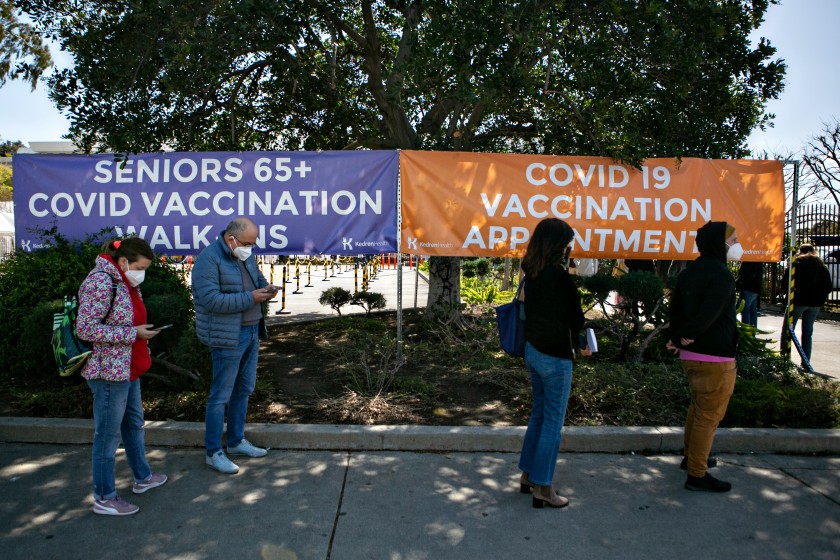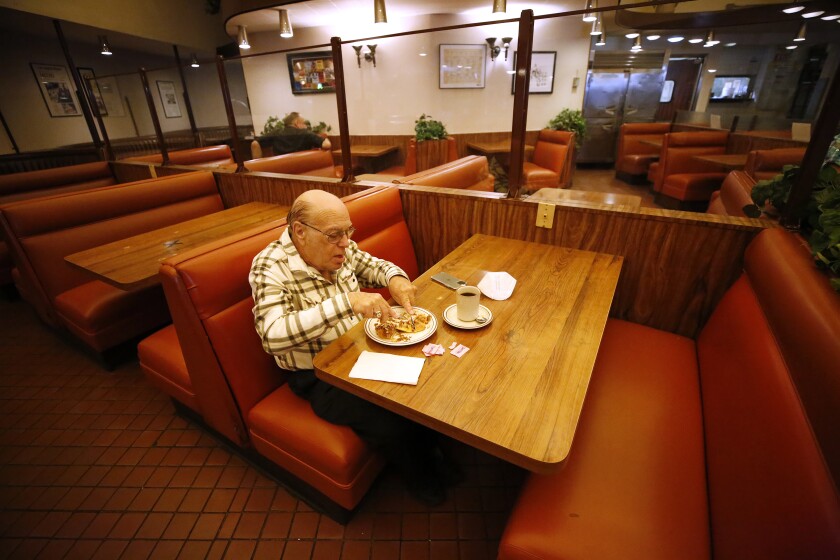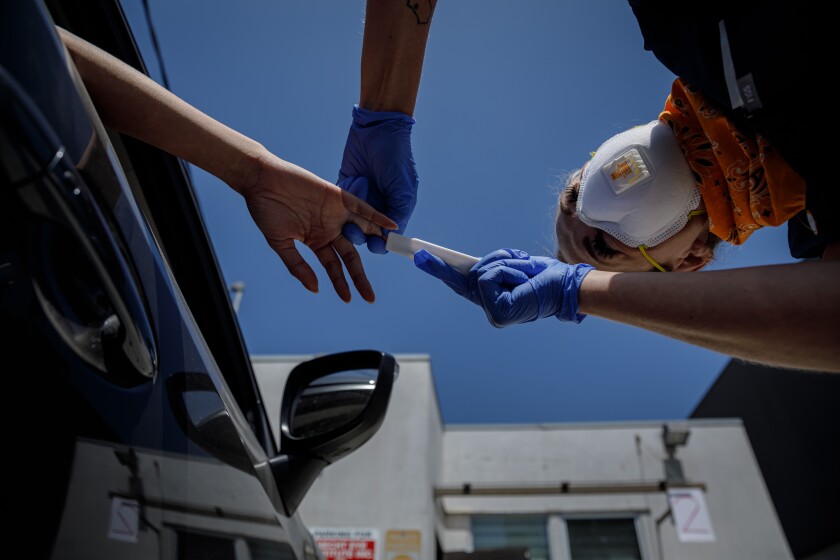California’s coronavirus canvas is taking on a distinctively red hue, with 10 more counties — including San Diego, Riverside, Sacramento, Ventura and Santa Barbara — escaping the most-restrictive rung in the state’s color-coded reopening roadmap this week.
The exodus from the strictest purple tier to the more lenient red tier, unveiled through updated data released Tuesday, leaves only a smattering of counties subject to the most severe limitations and represent the widest unlocking of the state’s economy in months.
The tier progression was made possible by a significant shift in California’s reopening strategy, one implemented after the state met its self-set goal of administering 2 million COVID-19 vaccine doses in the most disadvantaged communities.
Upon reaching that target, the state began allowing counties with a coronavirus case rate, adjusted based on the number of tests performed, of up to 10 new cases per day per 100,000 people to exit the purple tier. Previously, only counties with case rates at or below 7 new coronavirus cases per day per 100,000 people could move into the red tier.
California’s newest coronavirus vaccine rollout will live or die on trust and honesty. Will it work?
The looser requirement helped clear the way for 13 counties — Los Angeles, Orange, San Bernardino, Contra Costa, Sonoma, Placer, Mendocino, San Benito, Tuolumne, Siskiyou, Amador, Colusa and Mono — to progress over the weekend.
Ten more — Sacramento, San Diego, Riverside, Ventura, Lake, Monterey, Santa Barbara, Sutter, Tehama and Tulare — will do so effective Wednesday.
“This is great news for our region. San Diegans have done a good job following the public health guidance, and that has driven our case rate down in recent weeks,” county public health officer Dr. Wilma Wooten said in a statement before the official tier announcement. “Our vaccination efforts have also helped to slow the spread of COVID-19. As more people get vaccinated, the number of cases should continue to decrease.”
To advance, counties must meet not only the case rate requirement, but other thresholds regarding the rate of positive test results, and a health-equity metric intended to ensure that the positive case rate in poorer communities is not significantly worse than the county’s overall figure.
Counties need to record two straight weeks of qualifying data to advance.
After months of COVID-19 closures, Los Angeles County unlocked a significant portion of its battered business sector Monday, allowing in-restaurant dining, gym workouts, movie-going and a host of other activities at indoor venues.
Though the red tier is only the second step up the state’s reopening ladder — both the next orange tier and final yellow tier provide wider latitude for businesses and other public spaces to operate — reaching it is still significant.
Counties in the purple tier have to suspend or severely limit indoor operations across a wide swath of business sectors.
Moving to red, on the other hand, clears the way for them to permit indoor dining at restaurants and movie theater showings at 25% capacity; welcome back students in person in grades 7 through 12; reopen indoor gyms and dance and yoga studios at 10% capacity; and expand capacity caps at nonessential stores and libraries.
Fitness centers across L.A. County are allowed to reopen at limited capacity and with social distancing and other restrictions.
Museums, zoos and aquariums also can reopen indoors, at 25% capacity; and amusement parks can open at 15% capacity, with other modifications, starting April 1.
That same day, the cap on fan attendance would also be raised to 20% for live performances and outdoor sports.
The state’s tier framework sets a floor for how lenient counties can be when it comes to coronavirus-related restrictions. However, health officials at the local level can keep stricter rules in place.
The rapid move toward a significant reopening of the state’s economy reflects two trends: continued declines in coronavirus case rates and a steady increase in vaccinations.
The number of Americans who had been infected with the coronavirus before the holiday surge may have been twice as high as official tallies indicated.
Over the last week, California has reported an average of 3,151 new coronavirus cases per day, a nearly 40% decrease from two weeks ago, according to data compiled by The Times.
The number of severely ill COVID-19 patients has also tumbled. On Sunday, there were 3,119 coronavirus-positive Californians hospitalized statewide, with 862 of them in intensive care.
Both those figures are the lowest seen since early November, when the state’s catastrophic fall-and-winter wave was just beginning.
Daily deaths are falling, too, though they still remain high. Over the last week, an average of 224 Californians have died from COVID-19 each day.
The pandemic has claimed nearly 56,000 lives statewide.
Providers throughout California have administered more than 12.1 million total doses of COVID-19 vaccines — and roughly 1 in every 5 residents has gotten at least one shot, Times data show.
Over the last week, an average of 237,155 doses have been doled out per day statewide.
Though California has turned a significant corner in its fight against the coronavirus, the road ahead is not set in stone. Should too many people cast off their masks, crowd together and otherwise throw caution to the wind, officials and experts warn that the virus could easily rebound before enough people have been vaccinated to stave off another surge.
“That we’re here today is not a miracle,” L.A. County Public Health Director Barbara Ferrer said Monday. “Our recovery represents the deep commitment by hundreds of thousands of individuals, and many thousands of businesses, to adhering to safety measures and to making sacrifices that keep each other safe.”






















